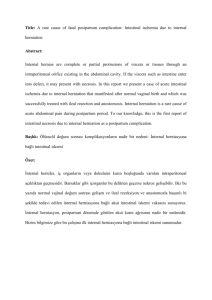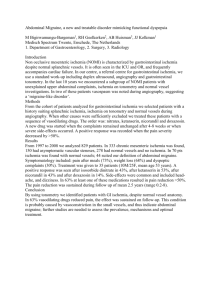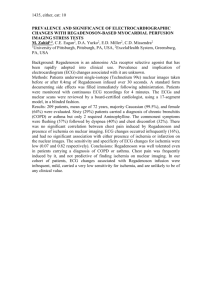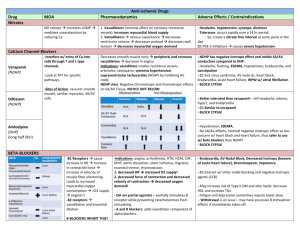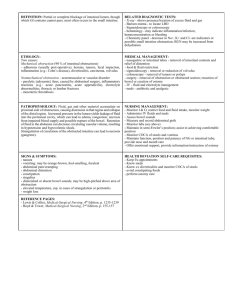intestinal ischemia - American College of Gastroenterology
advertisement
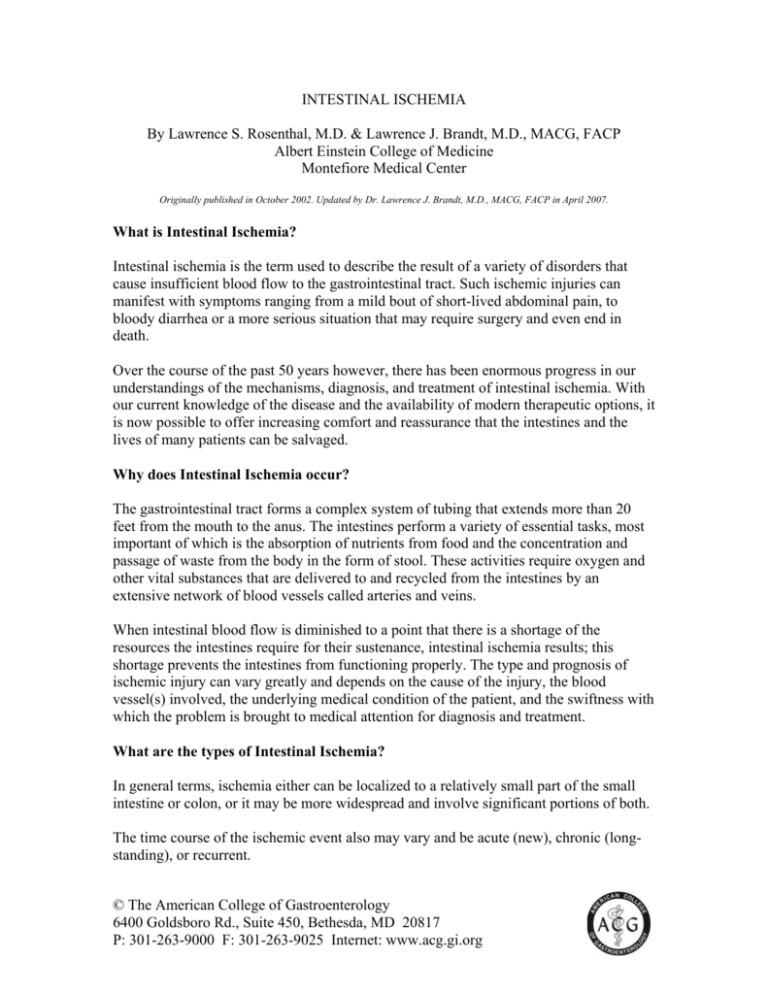
INTESTINAL ISCHEMIA By Lawrence S. Rosenthal, M.D. & Lawrence J. Brandt, M.D., MACG, FACP Albert Einstein College of Medicine Montefiore Medical Center Originally published in October 2002. Updated by Dr. Lawrence J. Brandt, M.D., MACG, FACP in April 2007. What is Intestinal Ischemia? Intestinal ischemia is the term used to describe the result of a variety of disorders that cause insufficient blood flow to the gastrointestinal tract. Such ischemic injuries can manifest with symptoms ranging from a mild bout of short-lived abdominal pain, to bloody diarrhea or a more serious situation that may require surgery and even end in death. Over the course of the past 50 years however, there has been enormous progress in our understandings of the mechanisms, diagnosis, and treatment of intestinal ischemia. With our current knowledge of the disease and the availability of modern therapeutic options, it is now possible to offer increasing comfort and reassurance that the intestines and the lives of many patients can be salvaged. Why does Intestinal Ischemia occur? The gastrointestinal tract forms a complex system of tubing that extends more than 20 feet from the mouth to the anus. The intestines perform a variety of essential tasks, most important of which is the absorption of nutrients from food and the concentration and passage of waste from the body in the form of stool. These activities require oxygen and other vital substances that are delivered to and recycled from the intestines by an extensive network of blood vessels called arteries and veins. When intestinal blood flow is diminished to a point that there is a shortage of the resources the intestines require for their sustenance, intestinal ischemia results; this shortage prevents the intestines from functioning properly. The type and prognosis of ischemic injury can vary greatly and depends on the cause of the injury, the blood vessel(s) involved, the underlying medical condition of the patient, and the swiftness with which the problem is brought to medical attention for diagnosis and treatment. What are the types of Intestinal Ischemia? In general terms, ischemia either can be localized to a relatively small part of the small intestine or colon, or it may be more widespread and involve significant portions of both. The time course of the ischemic event also may vary and be acute (new), chronic (longstanding), or recurrent. © The American College of Gastroenterology 6400 Goldsboro Rd., Suite 450, Bethesda, MD 20817 P: 301-263-9000 F: 301-263-9025 Internet: www.acg.gi.org An ischemic problem may be caused by an interruption in blood passage through an artery (a blood vessel that brings blood to the intestines) or vein (a blood vessel that returns blood from the intestines to the heart.) There are several ways in which arterial blood delivery to the intestines can be restricted: an embolus (a migrating blood clot that can form a blockage), a thrombus (a stationary clot attached to the wall of a blood vessel that can prohibit blood passage), or a so-called non-occlusive state (poor blood flow through an artery because of spasm in the blood vessel, but without a permanent obstruction). Venous problems also may result in intestinal ischemia, although less commonly than arterial causes. The most common cause of ischemia from venous obstruction is a thrombus which interferes with the return of blood flow from the intestines, produces intestinal congestion, and results in intestinal swelling, and perhaps bleeding. What are the possible consequences of Intestinal Ischemia? The ultimate effects of reduction in intestinal blood flow vary. The milder forms of these injuries may involve several days of abdominal discomfort and altered bowel habits (e.g., diarrhea, bloody stool) or chronic low-grade cramping abdominal pain associated with eating (“intestinal angina”). The more severe cases may present with life-threatening gangrene and rupture of the intestines or bleeding, and may require hospitalization and surgery. In order to take full advantage of the advances made in the diagnosis and treatment of these disorders and to improve the chances of recovery, early diagnosis is essential. Individuals who experience the symptoms detailed below, particularly those persons who are identified at greatest risk for intestinal ischemia, should seek the attention of their physician immediately. What are the signs and symptoms of Intestinal Ischemia? There is a broad spectrum of presentation of intestinal ischemia. There is no single set of symptoms which can fully predict the type of ischemic injury, its cause or its prognosis. There are, however, some generally recognized patterns of ischemic disease. The most common form of ischemic injury to the intestines is colon ischemia. Colon ischemia usually manifests as sudden, mild-to-moderate left-sided abdominal pain with an urgent desire to defecate, and the passage, within 24 hours, of bright red or maroon blood mixed with the stool. The vast majority of patients with colon ischemia do well; a minority develops irreversible disease such as chronic ischemic colitis, stricture (narrowing) formation or gangrene. Most patients with an acute episode of small intestinal ischemia usually present with the sudden onset of severe abdominal pain. Early in the process, the abdomen is usually soft, flat, and not tender to touch. Abdominal distention, may be the first sign of a serious © The American College of Gastroenterology 6400 Goldsboro Rd., Suite 450, Bethesda, MD 20817 P: 301-263-9000 F: 301-263-9025 Internet: www.acg.gi.org injury to the intestines. A sudden, forceful bowel movement associated with severe abdominal pain suggests an acute arterial occlusion caused by an embolus. A more slowly developing course usually occurs when small intestinal ischemia is caused by an arterial obstruction due to a thrombus. This episode is often preceded by weeks-tomonths of abdominal pain after meals, weight loss, and a change in bowel habits (e.g., loose stools). Patients with acute small intestinal ischemia resulting from a thrombus in a vein rather than an artery also experience abdominal pain. The pain is more variable and typically less severe than with arterial thrombosis. Other symptoms may include nausea, vomiting, and diarrhea with or without blood. Here again, patients usually have already had more subtle symptoms prior to the sudden event. The presence of abdominal pain after meals in the weeks to months before an acute event is sometimes a prelude to such an occurrence. Many patients with a venous thrombus have been diagnosed with blood clots in the past or have a high risk of developing clots because of a familial disease (clotting disorder) or another condition such as cancer, lupus, or because they taking medications that may promote clotting such as birth control pills. The presence of non-occlusive acute small intestinal ischemia may be overshadowed by the other illnesses a patient might have, such as heart failure, hypotension (low blood pressure), a heart attack, or cardiac arrhythmia (irregular heart beat). A patient in these settings may already be quite ill and abdominal pain may be absent. Unexplained abdominal distention or bleeding from the rectum may be the only signs of intestinal ischemia in these circumstances. Chronic small intestinal ischemia (or “intestinal angina”) is typically associated with dull, cramping abdominal pain felt 10 to 30 minutes after eating and reaches its peak 1 to 3 hours after a meal. The pain can increase in severity to the point where the patient fears eating and therefore reduces the size of meals or eats less frequently and exhibits signs of weight loss. Symptoms of this condition, in contrast to those of the other intestinal ischemic disorders, usually become progressively more severe over an extended period of time, without resulting in a severe crisis until late in the picture. Who is at risk for Intestinal Ischemia? The identification of intestinal ischemia often involves a high level of suspicion. Generally, those who are most susceptible are individuals over the age of 50 years, particularly those who suffer from diseases such as heart failure, and irregularities of the cardiac rhythm, or those who have had a heart attacks or stroke. Another category of people at risk for intestinal ischemia are those who have been diagnosed with, or are predisposed to develop a blood clot, also called a venous thrombosis. This problem can affect young people as well as older individuals and is most often seen in those who have suffered a recent traumatic leg injury and individuals who have been immobile for long © The American College of Gastroenterology 6400 Goldsboro Rd., Suite 450, Bethesda, MD 20817 P: 301-263-9000 F: 301-263-9025 Internet: www.acg.gi.org periods of time. Others at increased risk for blood clots are those who have either a predisposing genetic disorder, cancer, or those who use birth control pills. How is Intestinal Ischemia diagnosed and treated? The diagnosis and treatment of intestinal ischemia varies somewhat depending on the particular patient, suspected source, and clinical situation. What is consistent and clear, however, is that early diagnosis is essential to improve the chances for a good outcome. In general, the longer the injury is sustained without treatment, the greater the chance that the damage done to the intestines will be irreversible. The first considerations for a physician in diagnosing intestinal ischemia are the patient’s past medical history, his or her current symptoms, and a thorough physical examination. The diagnostic tools most commonly used to supplement this information include routine blood tests, colonoscopy, ultrasound, abdominal x-rays including CAT scans, MRIs and mesenteric angiography, and exploratory abdominal surgery. Angiography is a special xray study of the inside of one’s blood vessels. A contrast material is injected through a small catheter placed into an abdominal artery or vein, after which x-ray images of the vessels are generated. In acute small intestinal ischemia, particularly cases caused by arterial blockage, initial management of the patient includes addressing the relevant underlying medical conditions, intravenous or “IV” fluids, and antibiotics to prevent possible infection. Angiography is considered the gold standard for diagnosis and is usually performed after a CT scan has shown that the abdominal pain is not caused by any other disorder that is mimicking intestinal ischemia. Afterwards, a treatment decision is made based largely upon the findings on angiography and the physician’s assessment of the patient’s clinical status. If a significant embolus or thrombus is found in a vessel and the patient appears quite ill, a laparotomy (open abdominal surgery) generally is recommended either to remove the obstruction in the artery or vein or create a bypass route for blood around the blockage. If, at the time of surgery, the surgeon finds segments of the intestine that are infarcted (dead), that portion of bowel is resected (removed), and the portions of the intestine above it and below are reconnected. A second operation may be performed within 24 hours to see if the now treated blood vessels have allowed the previously injured portions of the intestine to recover. If so, there may be no need for further resection. Medication that dilates, or widens vessels in order to improve intestinal blood flow can be given via the catheter put in place during angiography, usually prior to, but occasionally after, surgery. When a venous obstruction is suspected, CT scan has been used successfully for diagnosis. Angiography can be used more selectively to aid in treatment of a particular vein. When patients are demonstrated to have a thrombus in a vein and are not considered to have signs of infarction, anticoagulant (“blood thinning”) drugs, and/or medication aimed toward dissolving the clot can be used. If a patient develops signs of more © The American College of Gastroenterology 6400 Goldsboro Rd., Suite 450, Bethesda, MD 20817 P: 301-263-9000 F: 301-263-9025 Internet: www.acg.gi.org threatening ischemia, surgery is indicated to remove clots and any unsalvageable segments of the intestines, as discussed above. In cases of non-occlusive intestinal ischemia, there is no identifiable point of blockage seen by angiography. Rather, the blockage is caused by diffuse spasm in the blood vessels supplying the intestines and the spasm is precipitated by underlying medical conditions such as heart failure; these underlying conditions must be addressed to help restore blood delivery to the intestines. Patients with such spasm may benefit from by administration of a vasodilator through a catheter directly placed in the main blood vessel supplying the intestine to break the spasm and thereby improve intestinal blood flow. In colon ischemia, the extent and severity of the injury again dictates the action taken. If the patient is stable, colonoscopy is ideally performed within 24-48 hours of the onset of symptoms. Patients in this situation can expect to be placed on a restricted diet in the short-term, and given antibiotics to prevent serious infection. In most cases, symptoms abate within 1 to 2 days and the injury to the colon can resolve in 1 to 2 weeks. A minority of patients develop more significant consequences and are treated accordingly, possibly with surgery. What are the risks and benefits of therapy for Intestinal Ischemia? The complications of angiography and medication infusion by catheter have included transient, reversible kidney problems, and bruising at sites of catheter insertion. With more significant surgical procedures there are, of course, additional risks. However, the alternative of delayed diagnosis in treatment of intestinal ischemia, particularly in cases of acute small intestinal ischemia, offers far more devastating consequences. Such delay, particularly of waiting until intestinal infarction develops, carries a mortality, or death, rate of 70%-90%. At our medical center, more than 50% of patients with acute small intestinal ischemia have survived because of our aggressive approach, using early diagnosis and prompt therapy with vasodilators and surgery; more than 75% have lost no more than a small fraction of their intestines. The importance of early diagnosis is demonstrated by the fact that 90% of patients who were ultimately diagnosed with acute small intestinal ischemia, but who had not developed late signs of ischemic damage such as peritonitis (inflammation of the tissue lining the inside of the abdomen), survived this injury. In other words, people who sought out their physicians and who had their disease diagnosed at an early stage of intestinal ischemia had a much better outcome than those in whom diagnosis was made late. Conclusion Intestinal ischemia can be a devastating disease. Physicians as recently as the first half of the 20th century expressed significant pessimism regarding the prognosis of patients who contracted this condition. There has been extraordinary progress, however, in medical understanding of intestinal ischemia over the past 50 years; a growing number of physicians now recognize and diagnose intestinal ischemia early, thereby improving the © The American College of Gastroenterology 6400 Goldsboro Rd., Suite 450, Bethesda, MD 20817 P: 301-263-9000 F: 301-263-9025 Internet: www.acg.gi.org outcomes for their patients. Current management of intestinal ischemia has evolved from simply managing the grave consequences after an acute event to more aggressive and proactive methods aimed toward recognizing and exploring early warning signs and preventing potentially catastrophic complications. It is essential to emphasize that successful management of intestinal ischemia involves a partnership between patients and their physicians. Recognition of the early symptoms and risk factors for the disease by patients greatly enhances their physicians’ ability to offer a diagnosis and cure. © The American College of Gastroenterology 6400 Goldsboro Rd., Suite 450, Bethesda, MD 20817 P: 301-263-9000 F: 301-263-9025 Internet: www.acg.gi.org


